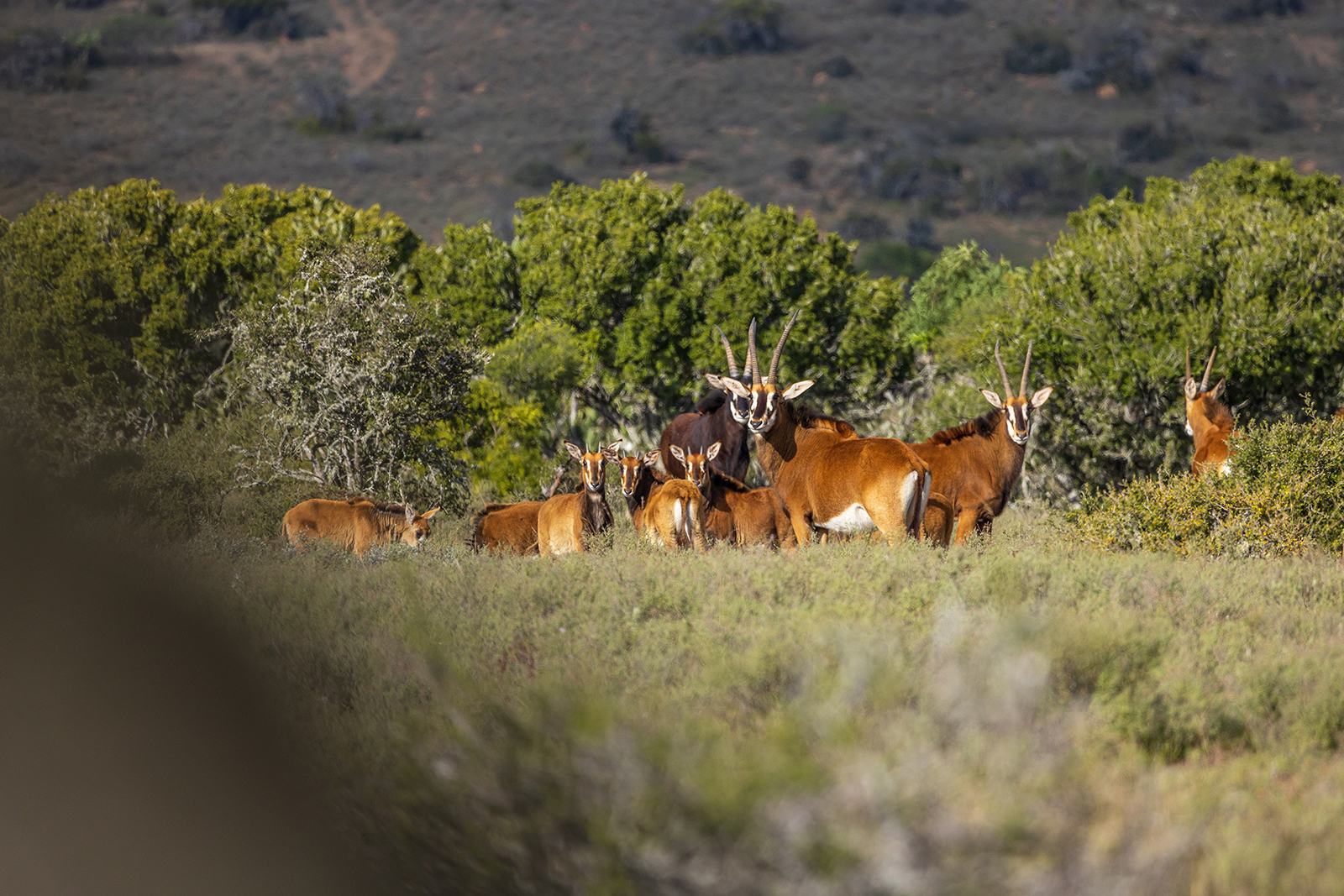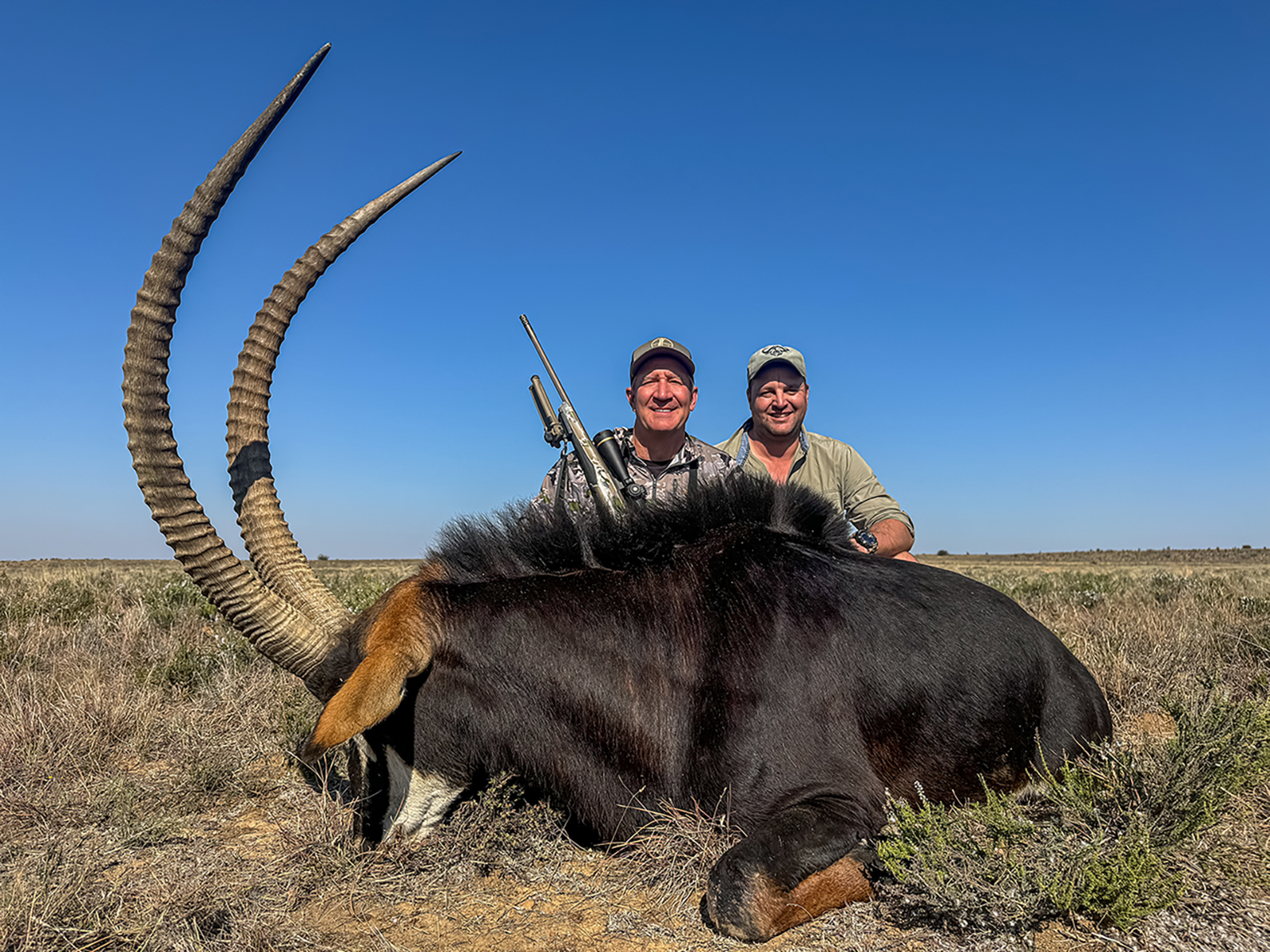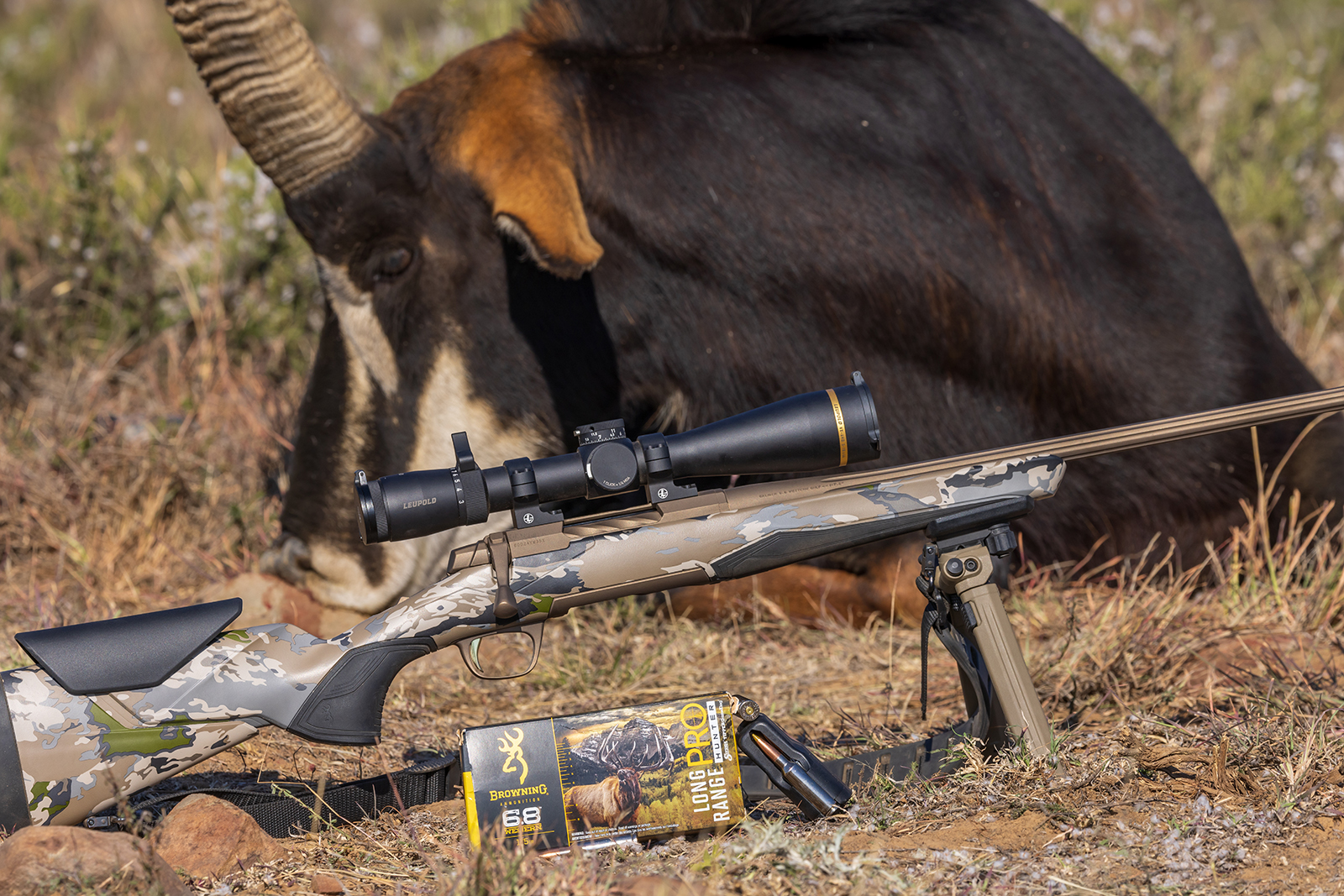Dawn broke in the hills surrounding the little lodge in remote Zimbabwe, and just as I had every morning for the past week, I dipped crunchy rusks into hot tea, savoring the moment. Watching the sky transition from orange to yellow to white, this was going to be a special day. We were going after sable, the iconic antelope that had eluded me on several prior safaris.
There was no rush. It was winter. The nights were cold and as with many places in Africa, big game doesn’t start moving here until the morning sun warms the earth.
Unexpectedly, a rhythmic pounding on metal interrupted the twilight bird calls. The echoing sounds of zebra and wildebeest were hushed as well. “Let’s grab our gear and head up the hill, sounds like my dad might be needing some help,” said Jonathan Collet, a professional hunter and owner of the lodge.
We gathered our gear and loaded the utility vehicle. Collet drove and I sat in the back, atop the high rack with a tracker named Sequiley. Cresting a steep hill, we approached Collet’s water and fuel tanks. Before we got there, Collet slammed on the brakes.
It wasn’t Collet’s father we’d heard working. Instead, we came face-to-face with about 12 men, all armed. Some were standing, some sat in the two trucks, others milled about the area.
“Take your jacket off, place it on the roof, dump all of your shells on to it,” Collet firmly instructed. “Load your rifle and if things go south, shoot all you can then take the rig and drive as fast as you can until you get to town.”
I didn’t know how many men we were confronting, exactly, but I quickly realized that my bolt gun would be no match for the ARs, shotguns, and old rifles they held.
The men were stealing fuel from Collet, filling up 50 gallon drums in the backs of their trucks. Heated, Collet spoke to them in their native language. They were from a nearby village and had recently been poaching and squatting on Collet’s property as well as within his vast hunting concession.
The exchange of words grew intense. I had both hands on my rifle as it lay atop the roof, safety off, finger on the trigger. The thieves stood their ground, firmly holding their weapons, but they never pointed them at us. “Our plans just changed,” said Collet.
“They want meat,” he said. “They were going to shoot what they wanted but I convinced them to let us do it. They’re going to wait here for us. I’m going to drive and you’re going to shoot.”
Collet sped down a dirt road, a rooster tail of red dust kicking up behind us. “Shoot everything in the head, we don’t have time to track,” Collet ordered. A half hour later we delivered two impala and a zebra to the thieves, but they wanted more. An hour later we were back with another load of animals. That satisfied them, at least for the time being.
Only recently had locals begun squatting and stealing from landowners.
Nothing would be done about it, but Collet had to document the encounter with authorities. He knew things were only going to get worse. And indeed, a few months later Collet lost his home, lodge, and all of his land to villagers who overtook it; many people in the area did. Collet was fortunate to have escaped alive.
Photo by Scott Haugen
Still, that afternoon we hunted sable — without luck. For the next two days we searched for them, but we didn’t find a single one. What we did find were numerous snares set by poachers, some of which held dead, rotting game, including an eland.
We came across a small cave where poachers were staying. A fire was still burning. Spears and snares were present. We found one poacher and knew that more were out there. Whatever game hadn’t been killed had been run off.
This was 2013 and my third safari with Collet. It had also been one of my several luckless hunts for sable. I would travel to Africa a total of 15 times and never have the opportunity to shoot a mature sable bull, even though it had become the critter I wanted the most. It began to feel like a curse. But, maybe my sixteenth safari would be different.
The Prince of Africa

Photo by Scott Haugen
Sable are one of Africa’s most iconic animals, referred to as the “prince of Africa.” The jet black hide of a bull sable is accented with stark white markings on the belly and face. Their scimitar-shaped horns sweep over their backs. Their thick chest, narrow waist and back end, combined with sharply tapered legs, give them the appearance of a sturdy horse. Their beauty and physique command attention. A mature bull will weigh 500 pounds. When I first hunted sable in the 1990s, a bull with 36-inch long horns was considered the holy grail. Today, that number has pushed to 40 inches. I had photographed bulls that big in parks throughout Africa, but never seen one that large while hunting.
From the 1950s through the 1970s, tsetse fly outbreaks greatly reduced sable numbers throughout their range. But by the 1980s, sable were bouncing back.
Still the price tag on a bull was steep, upwards of $15,000 in the 1990s.
As with many hunters, my infatuation with Africa took root at a young age. Lion hunting topped my wish list. Kudu were next, followed by sable. Throughout my many travels to the Dark Continent, ancient rock art depictions of sable have distinctly stood out. The clarity of this animal’s anatomy leaves no question as to what indigenous peoples were drawing.

Photo by Scott Haugen
Unlike many of Africa’s antelopes, sable routinely stand their ground when confronted by predators. They’ve been known to impale lions, leopards, and other predators with their sharp, horns upon attack. The fearless nature and tendency of standing their ground frequently leads to the sable’s demise at the hands of poachers, who hunt with dogs and spears. The dogs bay the sable, and then poachers move in with spears. Entire bachelor herds and matriarchal herds are often killed all at once. Poaching knows no limits in Africa and it has wiped out sable in many of their native habitats over the decades.
Sable are an edge species, living where grasslands and woodlands overlap. They depend on water, visiting pools or small streams daily. They like to graze on green grass, but they also rely on dry grasses, forbs, and leaves.
The sable’s requirements make lowland habitats from Tanzania to South Africa its ideal range. This means that sable are often in competition with farmers. Agriculture has led to the degradation of much of the sable’s habitat. Today, private landowners and parks are to thank for the decades-long conservation effort that has restored sable populations, thus providing more hunting opportunities than what existed 30 years ago. As with all African antelope that thrive, hunting helps control their overpopulation, and since meat cannot be shipped internationally, much of it is given to locals and made available at markets.
The Long Hunt
I first hunted sable in the early 1990s. I had connected with an outfitter along South Africa’s Limpopo River who told me he had good sable and buffalo in a concession across the river, in Zimbabwe. The prices on each were remarkably good. Too good, it would turn out.
“Whatever you do, do not cross the border with your PH,” whispered a dinner guest one evening, referring to my professional hunter, as guides are known in Africa. “I’ve been best friends with your PH for over 60 years, and he’s not licensed to hunt that area. And if you tell him I told you this, I’ll call you a liar. Whatever you have to do, get out of it.”
The man’s words resonated, and knowing poachers were shot on sight there, I backed out of the hunt. I wanted a sable, but not this way.
A decade ago I hunted sable in Namibia. The area was experiencing an excessive drought and animals were scarce. I only saw one small bull that trip. I wanted a mature bull or nothing.
Sweet 16
Then, on a hunt last month in South Africa, my luck finally changed.
I was hunting with Charl le Roux, owner and operator of Rosedale Safaris, which has access to some of the most diverse habitats I’ve hunted and the quality of animals are among the best I’ve seen. Giant East Cape kudu, nyala, waterbuck, and eland are just the start. I’d hunted with le Roux before, near Port Elizabeth, and when I laid eyes on some massive sable, I vowed to return.
This was my 16th safari to Africa and I only wanted to hunt two animals this time — sable topped the short list. I brought along four trail cameras and early in the hunt le Roux and I set them in wooded areas near water in the Karoo region. It was one of the wettest falls they’d had in decades. Grasses were green, water holes full, and creeks were flowing in several drainages throughout the Karoo. The Karoo is a semi-arid landscape covering over 150,000 square miles of South Africa, about one third of its total area. We were in position early, glassing with the rising sun at our backs.I’d hunted this region multiple times over the past 25 years, and this was the greenest I’d ever seen it.
The first night we caught young bulls on camera. Over the next two days we captured more sable as they came to drink in various areas. One creek in particular became our target area, as some big bulls routinely visited it at night and even during the day.
On day three, le Roux took two friends for kudu in the mountains, so I hunted with one of his top guides, Pieter Zwiegelaar.
We watched a small herd of cow sable and a few calves feed their way from a wooded draw into nearby green grass. Then Zwiegelaarspotted two bulls over a mile away. He wasted no time setting up a spotting scope. I’d never looked at a sable through a rifle scope. I’d never seen a dead sable. I was not good at field judging them and didn’t know what to look for, but I got a quick lesson from Zwiegelaar
“You want thick bases and long, sweeping horns that taper and are sharp at the end,” he said. “Some horns flare out, others are narrow, so it’s best to take your time and study them at all angles. The more bulls you can get a look at, the quicker you’ll learn how to judge them.”
I’d never hunted with Zwiegelaar, either. Sitting, glassing, talking, I learned a lot about him and the sable we hunted.
Zwiegelaar is a patient man. He’s not quick to judge an animal. He wants to study it closely before conveying what it is he’s looking at. We looked at a few more bulls. Through the spotting scope he showed me and talked me through what it was I was looking at.
“When you see a true giant, you instantly know it,” he said. “Chances are, if you ask yourself if the animal you’re looking at is a shooter, or have to talk yourself into shooting it, it’s not going to be exceptional. When you see an animal and gasp, you’re likely looking at a giant.”
The land we hunted was rolling grasslands atop gently undulating hills with sparsely wooded draws in the bottoms. There were many places a big sable bull could hide, so we took our time. We looked at multiple bulls over the course of the morning.
As temperatures warmed and animals moved into the wooded draws, Zwiegelaar suggested we go for a walk. We concentrated efforts near where two trail cameras had been routinely catching sable moving to water during the middle of the day.
Wading through sparse grass and thorny brush, we moved slowly, covering every bit of ground with our eyes and optics. The experience reminded me of hunting river bottom whitetails back home — until we laid eyes on a big bull sable.
The bull stood facing us, head sharply turned over its right shoulder. It had no idea we were there. “He’s a nice bull, about 40-inches, but let’s keep looking,” Zwiegelaar instructed. And just like that, we were on the move. I had no chance at a rebuttal. The fact we’d just passed on what’s considered the magic mark for a prized sable left me questioning what else might be out there.
“Don’t worry, I think we can find a bigger bull,” Zwiegelaar consoled. I liked the man’s confidence and his ability to field judge an animal.
We’d caught three bulls on trail cameras here that were bigger than the one we’d just passed. Those were the bulls we were looking for. I’m not a trophy hunter. Though I’ve been fortunate to take numerous record book animals over the decades, I’ve never entered one in a record book. For me it’s about the challenge of chasing a mature animal, not how many inches of horn the critter carries. Truth is, I’d waited for this hunt for over 40 years, and I didn’t want it to end. We still had time.
We studied a couple other bulls in the distance. They were smaller than the one we’d passed. “Let’s finish walking this little ravine then we’ll take a break for lunch,” Zwiegelaar whispered.
We’d not gone 20 yards when Zwiegelaar stopped. It was so sudden I almost bumped into him. He instantly started glassing in front of us. I had no view. “This is a massive, massive bull,” Zwiegelaarwhispered. “I need to see how long it is though.”
The bull stood in a narrow trail in the trees. I eventually got a peek at it, and looking at the bull through binoculars, its mass instantly caught my attention. It was the thickest horned sable we’d seen. But the leaves alongside the trail obscured half the bull’s horns. Zwiegelaar got low and got a glance at the bull’s horns as it turned sideways; I could still only see a portion of the headgear.
Slowly Zwiegelaar stood and began erecting the shooting sticks. “This is a giant bull and you need to shoot it right now,” he whispered. With my Browning rifle in 6.8 Western settled solidly in the sticks, I took a range. The bull was facing us, 177 yards away. Zwiegelaar confirmed the distance with his rangefinding binocular.
“Hit it square in the chest,” Zwiegelaar whispered. I did just that.

Photo by Scott Haugen
The whack of the bullet was solid, as it always is when entering the brisket. The bull took off running through the trees then sprinted into the open. For the first time I got a clear look at his horns. Long, sweeping, glistening in the sunlight, it was an image I’ll never forget. The bull ran 40 yards and tipped over.
Approaching the downed bull was surreal. There was no shouting. No celebrating. No animated high-fives. This was a moment I’d anticipated for many years, one I was never quite sure I’d realize. I wanted to soak in every detail.
Read Next: Best Cartridges for Africa Plains Game
As I wrapped my hands around the bases of the bull’s horns, I realized the sable was even bigger than I imagined. The horns were sharp. The contrasting white and black features were even more striking up close. It was one of the most awesome-looking animals I’d ever seen. Zwiegelaar and I shook hands and embraced. Nothing needed to be said.
We field dressed the bull and headed to the skinning shed. I never asked how big the horns were and Zwiegelaar never offered an estimate. It didn’t matter, I knew it was big. As the caping began, Zwiegelaar broke the silence. “You know, in all my years as a PH, this is the biggest sable I’ve ever seen taken.” That’s when we finally put a tape to it. The horns measured an astounding 45-inches long with 10-inch bases; a true bull of a lifetime.
That night Zwiegelaar grilled fresh sable tenderloins over an open fire. They were remarkably delicious and reliving that hunt under the starlit African sky was a fitting end to a decades=long adventure.
Plains Game Gear

Photo by Scott Haugen
Quality optics and a flat-shooting rifle are key pieces of gear for hunting sable. Bulls are thick-chested their muscles are dense. Shots could easily range out to 400 yards in open plains.
For my hunt I carried Browning’s new X-Bolt 2 Speed rifle in a 6.8 Western. I’d seen this cartridge perform well on Roosevelt elk, which are much bigger than sable. I’d also shot bear with it and seen kudu, gemsbok, wildebeest and other tough African game taken cleanly with it. I found Browning’s Long Range Pro Hunter 175 grain Sierra Tipped Gameking bullet perfectly mushroomed in the hind quarter of my bull, having entered the brisket and traveled through the entire body cavity — including a stomach full of densely-packed grass.
The rifle was topped with a new Leupold VX-6HD scope with a customized CDS dial for this specific load. With a precise zero, the system allows you to simply range, dial, and shoot. The 3-18×44 scope was a perfect fit for an African plains game hunt. I found the clarity and ease of use of this scope to be very impressive.
Leupold’s XS 4 Pro Guide 15-45×65 spotting scope was a game-changer on this sable hunt. Its clarity allowed the PH to give me a crash course in judging sable bulls at great distances. “I’ve used a lot of spotting scopes over the years,” Zwiegelaar told me more than once during our hunt, “and this is the best I’ve seen.”
